
Dept. of Meteorology, University of Nairobi
FIGURES
Abstract
Monitoring of ultra violet (UV) radiation reaching the earth's surface has gained a lot of interest in view of the documentation that 1% decrease in ozone (O3) brings about 1.2 to 1.5% increase in biologically harmful ultra violet (UV) radiation. No continuous monitoring of UV radiation is performed in the equatorial African region. This study presents an indirect methodology of determining UV irradiance at Nairobi.
A Dobson spectrophotometer located at Chiromo, Nairobi, Kenya has been acquiring O3 measurements since 1984. In this study, a new technique is presented of deriving UV-radiation from the raw data of the Dobson O3 Spectrometer. Estimates of UV levels are thus theoretically generated.
A case study of UV patterns using six years of O3 data is presented. The generated UV levels seem to agree fairly well with the general patterns of UV-levels elsewhere in the tropics.
This methodology has a potential utility in over 100 countries where such similar instruments are located in that it will enrich global Ultra-Violet data base and thus provide a better understanding of the climatological behaviour of UV globally.
Introduction
The recent past has experienced a dramatic increase in the study of the spectral and temporal patterns of solar UV radiation due to its impacts on the biosphere. The last few years have experienced a fast growing interest of understanding UV-B irradiance with respect to other atmospheric components. Consequently, since only very few UV-B measurements are available, and only in limited locations around the world, theoretical studies based on radiative transfer methods have gone a long way in improving our understanding of the various characteristics influencing UV-B .
Many instruments have been developed modified for monitoring the Damaging portions of UV spectrum, such as the Brewer Spectrophotometer. In this context, therefore, The aim of this paper is to develop a theoretical technique of processing raw Dobson O3 spectrophotometerÕs radiance data to produce UV-A and UV-B spectral irradiance.
Theoretical considerations
In principal, UV-B measuring instruments (Tevini, 1993) may broadly be classified into two classes: broad band detectors and spectroradiometers. Broadband detectors are made sensitive to a certain l range in the UV-B by combinations of special filters. However, no broadband detector has an ideal l independent sensitivity over the UV-B range.
Spectroradiometers measure the radiation flux at individual l s with a relative narrow spectral band. The most precise spectral measurements are made with double monochromator spectroradiometers. The absolute calibration of UV-B detectors remains to be optimised: an uncertainty of 3-5% is currently considered as a good result.
One of the most commonly used spectroradiometers is the Dobson O3 Spectrophotometer. Total O3 observations are made with this instrument by measuring the relative intensities of selected pairs of UV l s (l ), called A, C, CÕ and D l s respectively (Komhyr, 1980). The general data reduction procedure is described in Komhyr (1980). The basic principle is based on difference (N) of logarithmic fractional transmittance of ultraviolet radiation, between the top of the atmosphere (Lo) and at the surface the earth (L)
N = Lo ? L = log Io /IoÕ - log I/I'.ÉÉÉÉÉÉÉÉÉÉÉÉÉÉÉÉÉÉÉÉÉ..É..........(2)
Observational procedure of total O3 provides for the determination of N values for each l pair.
Data and Methodology
N values for each l pair, and total O3 values, measured using Dobson O3 Spectrophotometer number 18, located at Chiromo campus, University of Nairobi, Kenya, were collected. Only those data obtained during clear conditions were considered [that is, Direct Sun (DS) measurements ].
Monthly standard lamp tests, ensured accurate measurements.
(i). Evaluation of IA, IC and ID
Assuming that a pair of l s e.g. A is affected by the same attenuation, except for O3 absorption, the irradiances IA, IC and ID are deduced by assuming a linear relationship between irradiance at top of atmosphere and the irradiance reaching the surface (assuming no O3 absorption occurs). Figure 1 shows that relationship.

Figure 1: The relative attenuation of Dobson O3 Spectrophotometer l pair
where I o, IÕ o = long and short l Extra terrestrial (ET) spectral irradiance, Iu = short wave radiation if no O3 absorption were to occur, I = actual radiation on the surface, I Õ = long wave radiation. From figure 1, linear attenuation implies that
![]() .............................(5)
.............................(5)
where l A and l AÕ are the l s corresponding to I o and I oÕ, respectively. a =![]() is known Frohlich (1986). Equation 2 can be rewritten as
is known Frohlich (1986). Equation 2 can be rewritten as ![]() ...................(6)
...................(6)
where ![]() . Total O3 is theoretically inversely related to I/IÕ . Thus, regressing I/IÕ against O3 we obtain
. Total O3 is theoretically inversely related to I/IÕ . Thus, regressing I/IÕ against O3 we obtain
![]() ........................................(7)
........................................(7)
b= ![]() (i.e. value of
(i.e. value of ![]() when O3= 0). Effectively, in this study, therefore, a monthly value of b is computed after regressing
when O3= 0). Effectively, in this study, therefore, a monthly value of b is computed after regressing ![]() on O3 for a given set of observations in a given month. By considering measurements taken within 30 minutes time interval the effect
of diurnal UV variability is minimised. This time interval is
adopted in this study. After determination of b, by considering equation (5) we have,
on O3 for a given set of observations in a given month. By considering measurements taken within 30 minutes time interval the effect
of diurnal UV variability is minimised. This time interval is
adopted in this study. After determination of b, by considering equation (5) we have,
![]() ...............................(8)
...............................(8)
then ![]() ...........................................(9)
...........................................(9)
where ao =(IÕ o - I o), and b are evaluated using ET solar spectral irradiance values for the respective l s obtained from Frohlich (1986).
Assuming a mean value of IÕ for the respective period (in this case a month) under consideration, I can then be computed from equation (9).
(ii) Method of analysis
Direct sun (DS) total ozone measurements for the periods January 1993 to January 1998 were collected. This way, the effect of clouds was eliminated. Frequency analysis of observation times of the measurements for the period 1993 to 1998 was performed. Only the months of January and September were considered, representing minimum and maximum ozone occurrence periods, respectively, over Nairobi (Muthama, 1989). By considering time intervals of 30 minutes in order to eliminate diurnal UV variability, the most frequent times of ozone observations in January were found to be at the time intervals 7:30 -8:00 and 11:30-12:00. The 11:30-12:00 time interval was also found to highly frequent in September and it was selected for analysis. The September 7:30-8:00 interval had only 3 data points and it was thus not included in the analysis.
The N values recorded from the instrument, for January and September,
were utilised to compute ![]() ratios using equation (6). The ratios, together with ozone values,
were then fitted into a linear distribution fit. Such fit was
preferred on the basis of the assumption that the two wavelengths
under consideration are relatively affected by the same attenuation,
apart from the ozone absorption. The b values from equation(7), for the A, C, and D wavelength pairs
were computed. By equation (9), IÕ values for January and September were obtained for both the two
time intervals.
ratios using equation (6). The ratios, together with ozone values,
were then fitted into a linear distribution fit. Such fit was
preferred on the basis of the assumption that the two wavelengths
under consideration are relatively affected by the same attenuation,
apart from the ozone absorption. The b values from equation(7), for the A, C, and D wavelength pairs
were computed. By equation (9), IÕ values for January and September were obtained for both the two
time intervals.
Results and discussion
The linear distribution fit on ![]() versus O3 is summarised in Table 3 below. A strong linear relationship
between O3 and
versus O3 is summarised in Table 3 below. A strong linear relationship
between O3 and ![]() is depicted. Both the low standard error and the negative slope
(b) of the regression equation is a further confirmation of this
result. This agrees well with theory that
is depicted. Both the low standard error and the negative slope
(b) of the regression equation is a further confirmation of this
result. This agrees well with theory that![]() is inversely proportional to O3 amounts. For both January and September the scatter diagrams
of
is inversely proportional to O3 amounts. For both January and September the scatter diagrams
of ![]() versus O3 (Figures 3a and 3b) show a clear inverse relationship between
the two variables. However, the September scatter diagram portrays
a markedly better defined inverse relationship by the fact that
the points are comparatively more packed together. A further investigation
of this finding could bring a better understanding of the relationship.
IA spectral irradiance values, generated for both January and September
at 11:30/12:00 are shown in figures 6a and 6b.
versus O3 (Figures 3a and 3b) show a clear inverse relationship between
the two variables. However, the September scatter diagram portrays
a markedly better defined inverse relationship by the fact that
the points are comparatively more packed together. A further investigation
of this finding could bring a better understanding of the relationship.
IA spectral irradiance values, generated for both January and September
at 11:30/12:00 are shown in figures 6a and 6b.
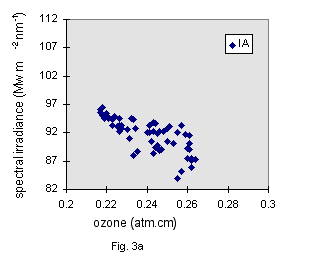
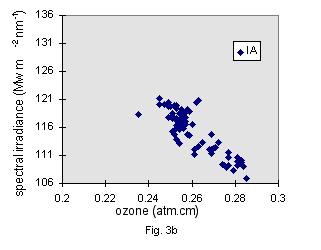
Figures 3a - 3b: January (a) and September (b) scatter plots for![]() versus O3 at 11:30 - 12:00
versus O3 at 11:30 - 12:00
| l pair | IA | IC | f ID | |||||||
| Month |
Jan. am pm |
Sept. |
Jan. am pm |
Sept. |
Jan. am pm |
Sept. | ||||
|
a b |
0.587 -0.581 |
0.612 -0.694 |
0.702 -1.049 |
0.575 -0.111 |
0.564 -0.073 |
0.729 -0.727 |
0.629 0.254 |
0.628 0.251 |
0.827 -0.535 |
|
|
s r |
0.006 0.820 |
0.009 0.735 |
0.007 0.869 |
0.007 0.215 |
0.008 0.138 |
0.006 0.830 |
0.008 0.445 |
0.009 0.386 |
0.006 0.718 |
|
|
Data points
|
40 | 59 | 78 | 40 | 59 | 78 | 40 | 59 | 78 | |
Table 3: Linear distribution fit for ID , IC and ID.
* Coefficients a and b are of the regression equation y = a + bx; s is standard error and r is correlation coefficient.
The regression analysis results of C wavelength pair (Tables 3) show a relatively poor correlation for January. However, The two scatter diagram suggests the presence of two distinct patterns, represented by the two generally outstanding clusters. This could be interpreted as an existence non-linear relationship within the considered time interval. Further investigation into these two clusters will throw some more light into this area.
Figures 7a and 7b are a plot of the determined UV spectral irradiances for wavelegth C. The 1994 ozone data period, which had low values, seems to be an outstanding feature for in Figures 7a and 7b. As compared to Figure 6a, the low ozone concentrations in Figure 7a are not accompanied to a marked UV increase. This could be attributed to the fact that UV absorption by ozone becomes less pronounced with increase in wavelength.
The UV-A wavelength linear distribution fit results (Table 3)
show significant negative correlation between ![]() and O3. Comparing Figures 5a-5b with Figures 3a-3b, where UV irradiance
is strongly absorbed by ozone, the January UV-A scatter diagrams
for January seem to be more scattered than those for UV-B. This
can be explained by the fact that UV-A, as compared to UV-B, is
absorbed less by ozone (Tevini, 1993). The generated irradiance
values are shown in Figures 8a and 8b.
and O3. Comparing Figures 5a-5b with Figures 3a-3b, where UV irradiance
is strongly absorbed by ozone, the January UV-A scatter diagrams
for January seem to be more scattered than those for UV-B. This
can be explained by the fact that UV-A, as compared to UV-B, is
absorbed less by ozone (Tevini, 1993). The generated irradiance
values are shown in Figures 8a and 8b.
The month of September seems to have relatively high UV irradiance values as compared to January: the September r values generally higher than the January ones. This could be attributed to the seasonal march of the sun. A better understanding of this observation could be attained if all the months of the year are studied.
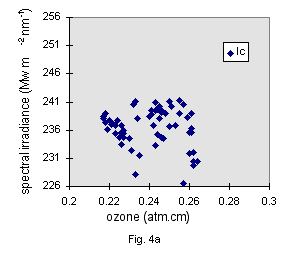
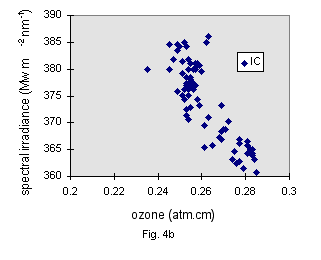
Figures 4a - 4b: January (a) and September (b) scatter plots for![]() versus O3 at 11:30 - 12:00
versus O3 at 11:30 - 12:00
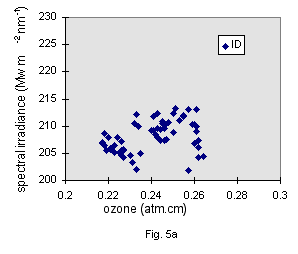
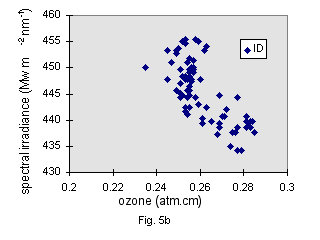
Figures 5a - 5b: January (a) and September (b) scatter plots for![]() versus O3 at 11:30 - 12:00
versus O3 at 11:30 - 12:00
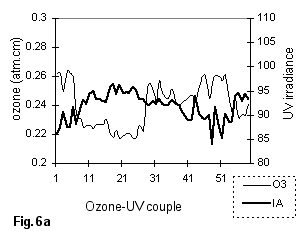
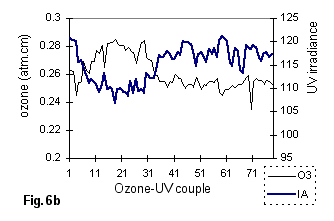
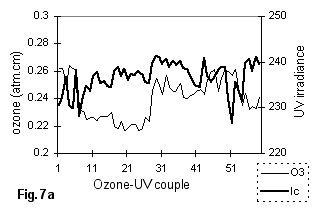
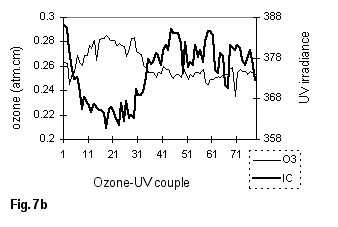
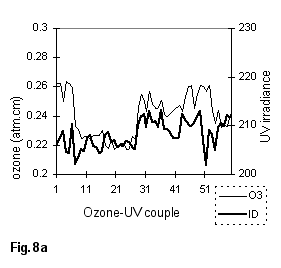
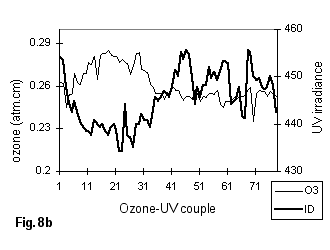
Conclusion
The linear distribution fit on ![]() versus O3 show a strong linear relationship between them. Both the low
standard error and the negative slope is a further confirmation
of this result. This forms a strong basis of the proposed UV derivation
methodology.
versus O3 show a strong linear relationship between them. Both the low
standard error and the negative slope is a further confirmation
of this result. This forms a strong basis of the proposed UV derivation
methodology.
Analysis of the C wavelength shows a relatively poor correlation for January. However, the corresponding scatter diagrams suggest the presence of two distinct patterns within the time interval, represented by the two generally outstanding clusters. This could be interpreted as an existence non-linear relationship within the two time intervals. Further investigation into these two clusters will throw some more light into this area.
References
Frohlich, C., 1988: Extraterrestrial solar radiation, Physical climatology for solar and wind energy, World Sientific, Ed. R. Guzzi and C. G. Justus.
Komhyr, W. D., 1980: Operation handbook - ozone observation with a Dobson spectrophtotmeter, WMO global ozone research and monitoring projetc report No. 6
Muthama, N. J., 1989: Total ozone characteristics over a tropical region, M.Sc. Thesis, Univ. of Nairobi., Kenya.
Tevini (Ed.), UV-B radiation and ozone depletion: effects on humans, animals, plants, micro-organisms, and materials, Lewis, Boca Raton, Florida, 95- 123, 1993.
Back to
| Session 1 : Stratospheric Processes and their Role in Climate | Session 2 : Stratospheric Indicators of Climate Change |
| Session 3 : Modelling and Diagnosis of Stratospheric Effects on Climate | Session 4 : UV Observations and Modelling |
| AuthorData | |
| Home Page | |